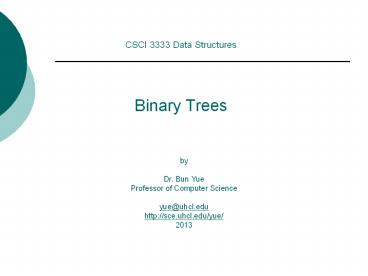Binary%20Trees - PowerPoint PPT Presentation
Title:
Binary%20Trees
Description:
... Inorder Traversal In an inorder traversal a node is visited after its left subtree and before its right subtree Application: draw a binary tree x(v) = inorder ... – PowerPoint PPT presentation
Number of Views:217
Avg rating:3.0/5.0
Title: Binary%20Trees
1
Binary Trees
CSCI 3333 Data Structures
byDr. Bun YueProfessor of Computer
Scienceyue_at_uhcl.eduhttp//sce.uhcl.edu/yue/201
3
2
Acknowledgement
- Mr. Charles Moen
- Dr. Wei Ding
- Ms. Krishani Abeysekera
- Dr. Michael Goodrich
3
Binary Trees
- A binary tree is a tree with the following
properties - Each internal node has at most two children
(exactly two for proper binary trees) - The children of a node are an ordered pair
- We call the children of an internal (interior)
node left child and right child
A
B
C
G
D
F
E
H
I
4
Binary Tree
- Alternative recursive definition a binary tree
is either - a tree consisting of a single node, or
- a tree whose root has an ordered pair of
children, each of which is a binary tree. - Some Applications
- arithmetic expressions
- decision processes
- searching
5
Arithmetic Expression Tree
- Binary tree associated with an arithmetic
expression - interior nodes operators
- leaf nodes operands
- Example arithmetic expression tree for the
expression (2 ? (a - 1) (3 ? b))
6
Decision Tree
- Binary tree associated with a decision process
- interior nodes questions with yes/no answer
- leaf nodes decisions
- Example dining decision
Want a fast meal?
Yes
No
How about coffee?
On expense account?
Yes
No
Yes
No
Starbucks
Spikes
Al Forno
Café Paragon
7
Properties of Proper Binary Trees
- Notation
- n number of nodes
- e number of external (leaf) nodes
- i number of internal nodes
- h height
- Properties
- e i 1
- n 2e - 1
- h ? i
- h ? (n - 1)/2
- e ? 2h
- h ? log2 e
- h ? log2 (n 1) - 1
8
BinaryTree ADT
- The BinaryTree ADT extends the Tree ADT, i.e., it
inherits all the methods of the Tree ADT - Additional methods
- position left(p)
- position right(p)
- boolean hasLeft(p)
- boolean hasRight(p)
- Update methods may be defined by data structures
implementing the BinaryTree ADT
9
Inorder Traversal
- In an inorder traversal a node is visited after
its left subtree and before its right subtree - Application draw a binary tree
- x(v) inorder rank of v
- y(v) depth of v
Algorithm inOrder(v) if hasLeft (v) inOrder (left
(v)) visit(v) if hasRight (v) inOrder (right (v))
6
2
8
1
7
9
4
3
5
10
Print Arithmetic Expressions
Algorithm printExpression(v) if hasLeft
(v) print(() inOrder (left(v)) print(v.element
()) if hasRight (v) inOrder (right(v)) print
())
- Specialization of an inorder traversal
- print operand or operator when visiting node
- print ( before traversing left subtree
- print ) after traversing right subtree
((2 ? (a - 1)) (3 ? b))
11
Evaluate Arithmetic Expressions
- Specialization of a postorder traversal
- recursive method returning the value of a subtree
- when visiting an internal node, combine the
values of the subtrees
12
Linked Structure for Trees
- A node is represented by an object storing
- Element
- Parent node
- Sequence of children nodes
- Node objects implement the Position ADT
B
?
?
A
D
F
B
D
A
F
?
?
C
E
C
E
13
Linked Structure for Binary Trees
- A node is represented by an object storing
- Element
- Parent node
- Left child node
- Right child node
- Node objects implement the Position ADT
?
?
?
B
A
D
?
?
?
?
C
E
14
Array-Based Representation of Binary Trees
- nodes are stored in an array
1
2
3
- let rank(node) be defined as follows
- rank(root) 1
- if node is the left child of parent(node),
rank(node) 2rank(parent(node)) - if node is the right child of parent(node),
rank(node) 2rank(parent(node))1
6
4
5
7
10
11
15
Space Complexity
- Big-Oh for Memory Requirement.
- Linked Structures worst case O(n), where n is
the number of nodes. - Array Representation Worst case O(2n) gt not
acceptable for many general binary tree
applications.
16
Questions and Comments?































